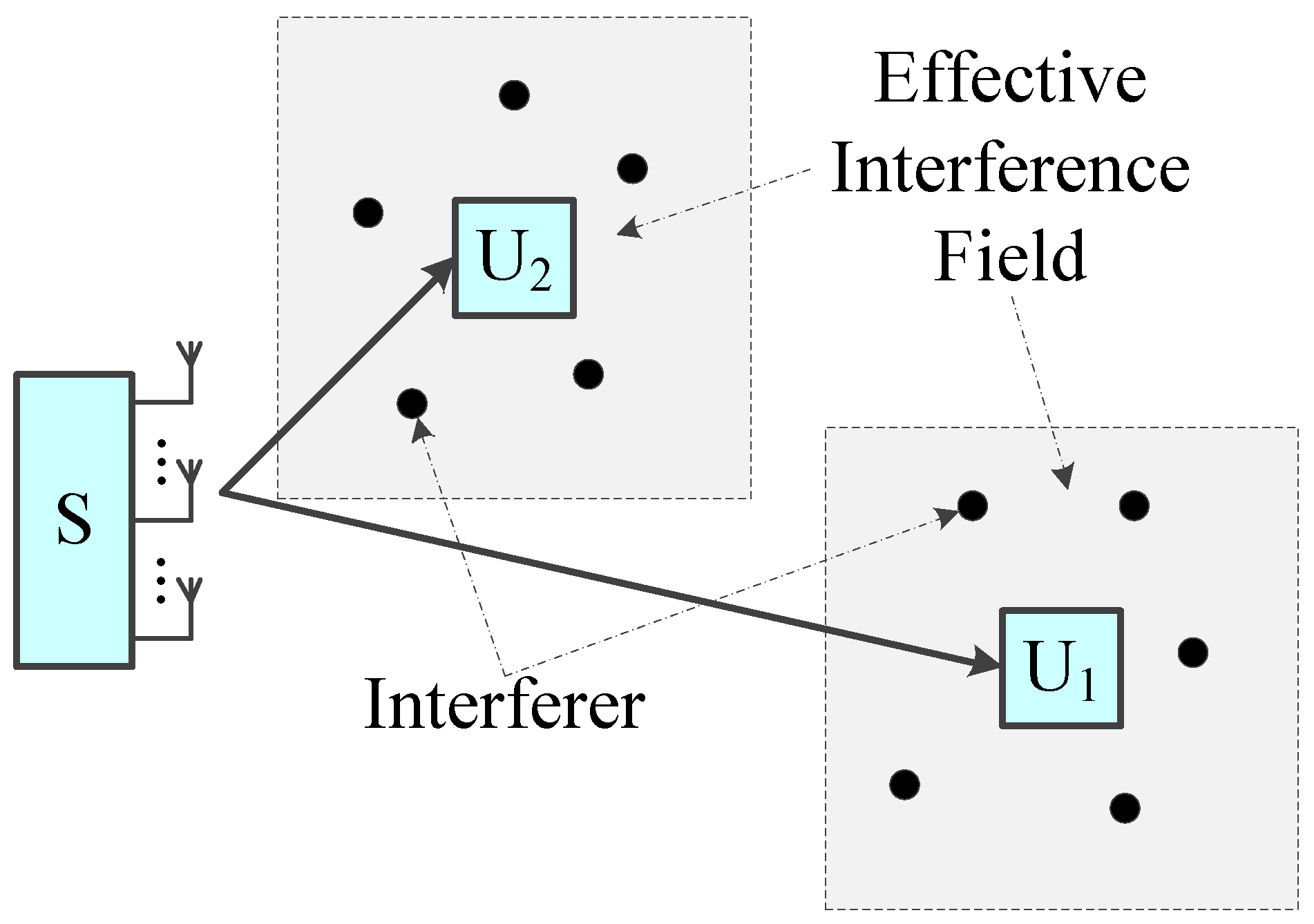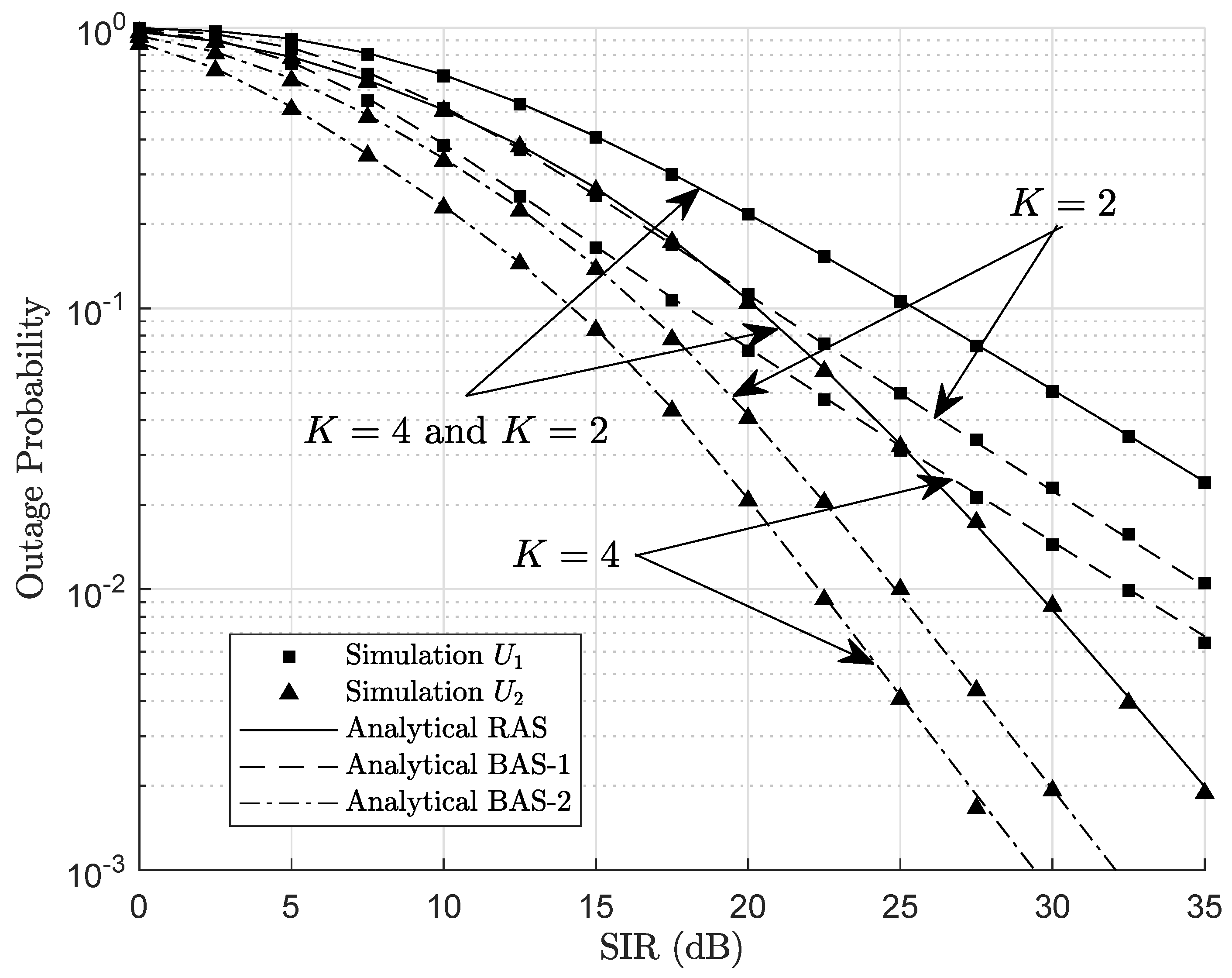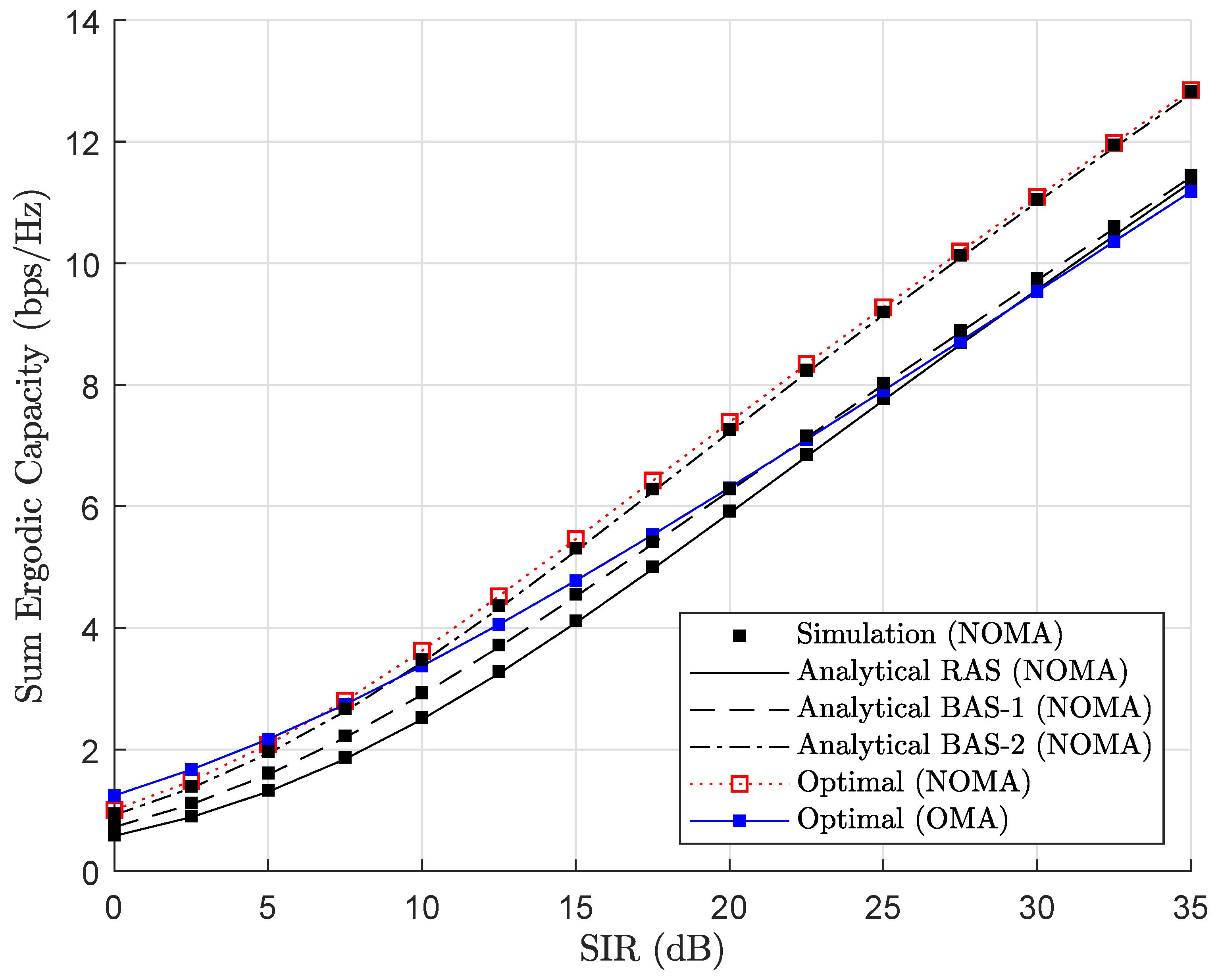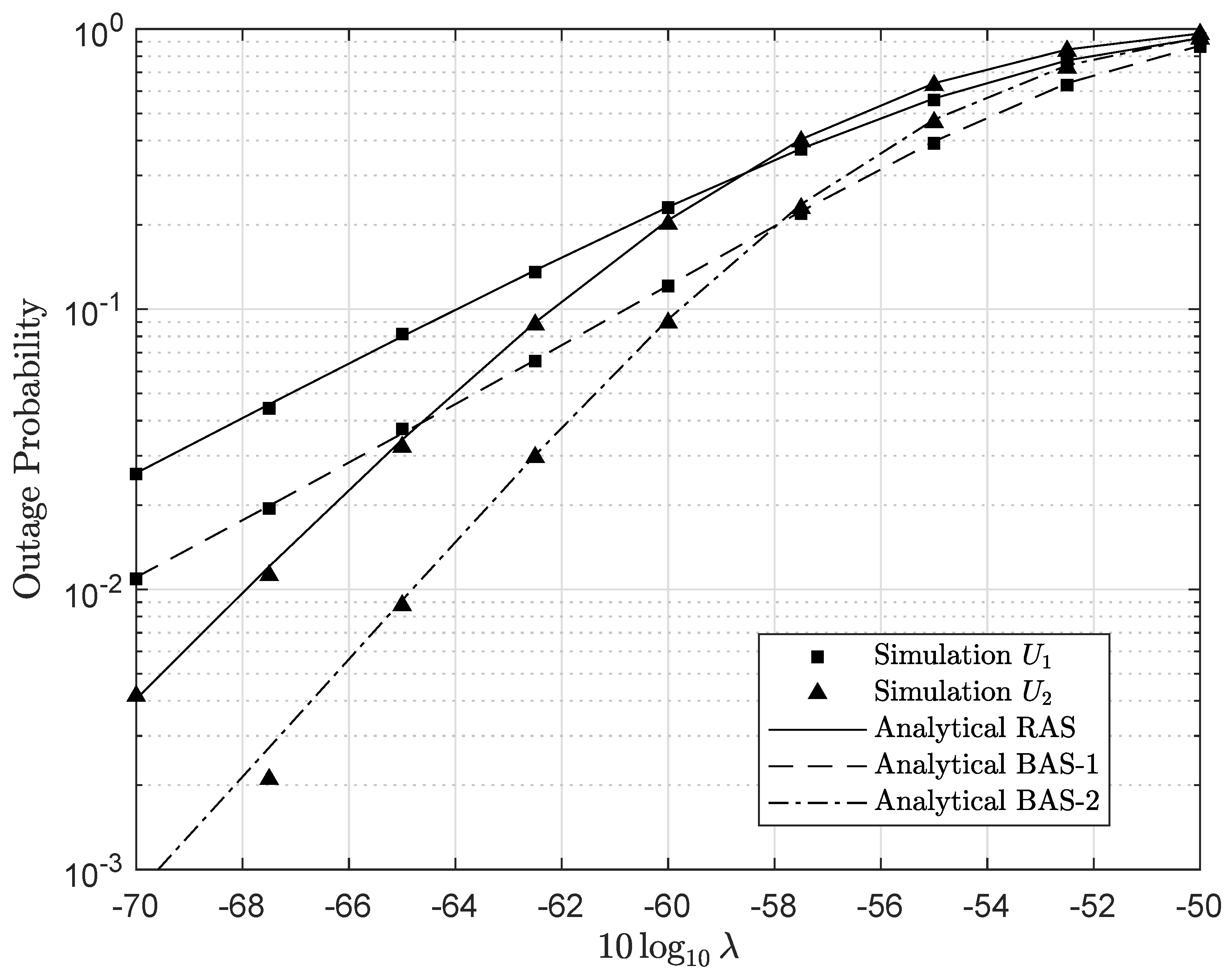Transmit Antenna Selection Schemes for NOMA with Randomly Moving Interferers in Interference-Limited Environment
Abstract
1. Introduction
- We analyze a downlink NOMA network with the degraded performance by randomly distributed interferers located near to users and the number and positions of interferers follow independent PPP. Closed-form expressions of outage probability for the proposed system are given.
- We provide transmit antenna selection schemes, i.e., random antenna selection (RAS) and Best Antenna Selection (BAS), which enable us to improve the quality of transmission and evaluate performance gap on these schemes.
- Lower bound of ergodic capacity and upper bound of outage probability happen at RAS mode for such system model. Moreover, improvement ergodic capacity can be observed via optimal ergodic capacity achieved by heuristic search method. The density of interference make a crucial impact on both outage probability and ergodic capacity performance.
2. System Model
3. Random Antenna Selection (RAS)
3.1. Outage Probability
3.2. Ergodic Capacity of
3.3. Ergodic Capacity of
4. Best Antenna Selection Mode
4.1. Best Antenna Serving (BAS-1)
4.2. Best Antenna Serving (BAS-2)
5. Numerical Results
- The number of transmit antennas, without pointing out, is set default at .
- The target data rates of and are (bps/Hz) and (bps/Hz), respectively. Furthermore, the power allocation are and .
- The shape parameters of the interference channels affecting and are , respectively.
6. Conclusions
Author Contributions
Funding
Conflicts of Interest
Appendix A. Proof of Lemma 1
References
- Li, X.; Li, J.; Liu, Y.; Ding, Z.; Nallanathan, A. Residual Transceiver Hardware Impairments on Cooperative NOMA Networks. IEEE Trans. Wirel. Commun. 2019. [Google Scholar] [CrossRef]
- Li, X.; Li, J.; Li, L. Performance Analysis of Impaired SWIPT NOMA Relaying Networks Over Imperfect Weibull Channels. IEEE Syst. J. 2019. [Google Scholar] [CrossRef]
- Nguyen, T.-L.; Do, D.-T. Power Allocation Schemes for Wireless Powered NOMA Systems with Imperfect CSI: System model and performance analysis. Int. J. Commun. Syst. 2018, 31, e3789. [Google Scholar] [CrossRef]
- Li, X.; Liu, M.; Deng, C.; Mathiopoulos, P.T.; Ding, Z.; Liu, Y. Full-Duplex Cooperative NOMA Relaying Systems with I/Q Imbalance and Imperfect SIC. IEEE Wirel. Commun. Lett. 2019. [Google Scholar] [CrossRef]
- Nguyen, T.-L.; Van Nguyen, M.S.V.; Do, D.-T.; Voznak, M. Enabling Non-Linear Energy Harvesting in Power Domain based Multiple Access in Relaying Networks: Outage and Ergodic Capacity Performance Analysis. Electronics 2019, 8, 817. [Google Scholar] [CrossRef]
- Do, D.-T.; Van Nguyen, M.-S. Device-to-device transmission modes in NOMA network with and without Wireless Power Transfer. Comput. Commun. 2019, 139, 67–77. [Google Scholar] [CrossRef]
- Do, D.-T.; Le, A.-T.; Le, C.-B.; Lee, B.M. On Exact Outage and Throughput Performance of Cognitive Radio based Non-Orthogonal Multiple Access Networks with and without D2D Link. Sensors 2019, 19, 3314. [Google Scholar] [CrossRef]
- Do, D.-T.; Le, A.-T. NOMA based cognitive relaying: Transceiver hardware impairments, relay selection policies and outage performance comparison. Comput. Commun. 2019, 146, 144–154. [Google Scholar] [CrossRef]
- Do, D.-T.; Le, A.-T.; Lee, B.-M. On Performance Analysis of Underlay Cognitive Radio-Aware Hybrid OMA/NOMA Networks with Imperfect CSI. Electronics 2019, 8, 819. [Google Scholar] [CrossRef]
- Do, D.-T.; Nguyen, M.-S.V.; Hoang, T.-A.; Lee, B.M. Exploiting Joint Base Station equipped Multiple Antenna and Full-Duplex D2D users in Power Domain Division Based Multiple Access Networks. Sensors 2019, 19, 2475. [Google Scholar] [CrossRef]
- Do, D.-T.; Le, C.-B.; Lee, B.M. Robust Transmit Antenna Design for Performance Improvement of Cell-Edge User: Approach of NOMA and Outage/Ergodic Capacity Analysis. Sensors 2019, 19, 4907. [Google Scholar] [CrossRef] [PubMed]
- Le, C.-B.; Do, D.-T. Joint Evaluation of Imperfect SIC and Fixed Power Allocation Scheme for Wireless Powered D2D-NOMA networks with multiple antennas at Base Station. Wirel. Netw. 2019, 25, 5069–5081. [Google Scholar] [CrossRef]
- Al-Hussaibi, W.A.; Ali, F.H. Efficient User Clustering, Receive Antenna Selection, and Power Allocation Algorithms for Massive MIMO-NOMA Systems. IEEE Access 2019, 7, 31865–31882. [Google Scholar] [CrossRef]
- Khan, A.S.; Chatzigeorgiou, I.; Lambotharan, S.; Zheng, G. Network-Coded NOMA with Antenna Selection for the Support of Two Heterogeneous Groups of Users. IEEE Trans. Wirel. Commun. 2019, 18, 1332–1345. [Google Scholar] [CrossRef]
- Lv, L.; Ni, Q.; Ding, Z.; Chen, J. Application of non-orthogonal multiple access in cooperative spectrum- sharing networks over Nakagami-m fading channels. IEEE Trans. Veh. Technol. 2017, 66, 5506–5511. [Google Scholar] [CrossRef]
- Ma, Z.; Zhang, Z.; Ding, Z.; Fan, P.; Li, H. Key techniques for 5G wireless communications: Network architecture, physical layer, and MAC layer perspectives. Sci. China Inf. Sci. 2015, 58, 1–20. [Google Scholar] [CrossRef]
- Yang, Z.; Ding, Z.; Fan, P.; Ma, Z. Outage performance for dynamic power allocation in hybrid non-orthogonal multiple access systems. IEEE Commun. Lett. 2016, 20, 1695–1698. [Google Scholar] [CrossRef]
- Li, X.; Li, C.; Jin, Y. Dynamic resource allocation for transmit power minimization in OFDM-based NOMA systems. IEEE Commun. Lett. 2016, 20, 2558–2561. [Google Scholar] [CrossRef]
- Yang, Z.; Ding, Z.; Fan, P.; Al-Dhahir, N. A general power allocation scheme to guarantee quality of service in downlink and uplink NOMA systems. IEEE Trans. Wirel. Commun. 2016, 15, 7244–7257. [Google Scholar] [CrossRef]
- Zhang, X.; Gao, Q.; Gong, C.; Xu, Z. User grouping and power allocation for NOMA visible light communication multi-cell networks. IEEE Commun. Lett. 2017, 21, 777–780. [Google Scholar] [CrossRef]
- Zhu, X.; Jiang, C.; Kuang, L.; Ge, N.; Lu, J. Non-orthogonal multiple access based integrated terrestrial- satellite networks. IEEE J. Sel. Areas Commun. 2017, 35, 2253–2267. [Google Scholar] [CrossRef]
- Yan, X.; Xiao, H.; Wang, C.-X.; An, K. Outage performance of NOMAbased hybrid satellite–terrestrial relay networks. IEEE Wireless Commun. Lett. 2018, 7, 538–541. [Google Scholar] [CrossRef]
- Yan, X.; Xiao, H.; An, K.; Zhen, G.; Tao, W. Hybrid satellite terrestrial relay networks with cooperative non-orthogonal multiple access. IEEE Commun. Lett. 2018, 22, 978–981. [Google Scholar] [CrossRef]
- Chen, Z.; Yuan, J.; Vucetic, B. Analysis of transmit antenna selection/maximal-ratio combining in Rayleigh fading channels. IEEE Trans. Veh. Technol. 2005, 54, 1312–1321. [Google Scholar] [CrossRef]
- Zhang, Y.; Ge, J.; Serpedin, E. Performance analysis of nonorthogonal multiple access for downlink networks with antenna selection over Nakagami-m fading channels. IEEE Trans. Veh. Technol. 2017, 66, 10590–10594. [Google Scholar] [CrossRef]
- Yu, Y.; Chen, H.; Li, Y.; Ding, Z.; Song, L.; Vucetic, B. Antenna selection for MIMO nonorthogonal multiple access systems. IEEE Trans. Veh. Technol. 2018, 67, 3158–3171. [Google Scholar] [CrossRef]
- Liu, X.; Wang, X. Efficient antenna selection and user scheduling in 5G massive MIMO-NOMA system. In Proceedings of the 2016 IEEE 83rd Vehicular Technology Conference (VTC Spring), Nanjing, China, 15–18 May 2016; pp. 1–5. [Google Scholar]
- Yu, Y.; Chen, H.; Li, Y.; Ding, Z.; Zhuo, L. Antenna selection in MIMO cognitive radio-inspired NOMA systems. IEEE Commun. Lett. 2017, 21, 2658–2661. [Google Scholar] [CrossRef]
- Liu, Y.; Qin, Z.; Elkashlan, M.; Gao, Y.; Hanzo, L. Enhancing the physical layer security of non-orthogonal multiple access in large-scale networks. IEEE Trans. Wirel. Commun. 2017, 16, 1656–1672. [Google Scholar] [CrossRef]
- Ding, Z.; Fan, P.; Poor, H.V. Random beamforming in millimeter-wave NOMA networks. IEEE Access 2017, 5, 7667–7681. [Google Scholar] [CrossRef]
- Zhou, Y.; Wong, V.W.S.; Schober, R. Dynamic decode-and-forward based cooperative NOMA with spatially random users. IEEE Trans. Wirel. Commun. 2018, 17, 3340–3356. [Google Scholar] [CrossRef]
- Zhou, Y.; Wong, V.W.S.; Schober, R. Stable Throughput Regions of Opportunistic NOMA and Cooperative NOMA with Full-Duplex Relaying. IEEE Trans. Wirel. Commun. 2018, 17, 5059–5075. [Google Scholar] [CrossRef]
- Heath, R.W.; Kountouris, M.; Bai, T. Modeling heterogeneous network interference using Poisson point processes. IEEE Trans. Signal Process. 2013, 61, 4114–4126. [Google Scholar] [CrossRef]
- Cardieri, P. Modeling interference in wireless ad hoc networks. IEEE Commun. Surv. Tutor. 2010, 12, 551–572. [Google Scholar] [CrossRef]
- Haenggi, M.; Ganti, R.K. Interference in large wireless networks. Found. Trends Netw. 2009, 3, 127–248. [Google Scholar] [CrossRef]
- Lai, X.; Zou, W.; Xie, D.; Li, X.; Fan, L. DF relaying networks with randomly distributed interferers. IEEE Access 2017, 5, 18909–18917. [Google Scholar] [CrossRef]
- Ganti, R.K.; Haenggi, M. Spatial and temporal correlation of the interference in ALOHA ad hoc networks. IEEE Commun. Lett. 2009, 13, 631–633. [Google Scholar] [CrossRef]
- Haenggi, M. Diversity loss due to interference correlation. IEEE Commun. Lett. 2012, 16, 1600–1603. [Google Scholar] [CrossRef]
- Soulimani, A.; Benjillali, M.; Chergui, H.; da Costa, D.B. On Multihop Weibull-Fading Communications Performance Analysis Framework and Applications. arXiv 2016, arXiv:1610.08535. [Google Scholar]






© 2019 by the authors. Licensee MDPI, Basel, Switzerland. This article is an open access article distributed under the terms and conditions of the Creative Commons Attribution (CC BY) license (http://creativecommons.org/licenses/by/4.0/).
Share and Cite
Do, D.-T.; Nguyen, T.-L.; Lee, B.M. Transmit Antenna Selection Schemes for NOMA with Randomly Moving Interferers in Interference-Limited Environment. Electronics 2020, 9, 36. https://doi.org/10.3390/electronics9010036
Do D-T, Nguyen T-L, Lee BM. Transmit Antenna Selection Schemes for NOMA with Randomly Moving Interferers in Interference-Limited Environment. Electronics. 2020; 9(1):36. https://doi.org/10.3390/electronics9010036
Chicago/Turabian StyleDo, Dinh-Thuan, Thanh-Luan Nguyen, and Byung Moo Lee. 2020. "Transmit Antenna Selection Schemes for NOMA with Randomly Moving Interferers in Interference-Limited Environment" Electronics 9, no. 1: 36. https://doi.org/10.3390/electronics9010036
APA StyleDo, D.-T., Nguyen, T.-L., & Lee, B. M. (2020). Transmit Antenna Selection Schemes for NOMA with Randomly Moving Interferers in Interference-Limited Environment. Electronics, 9(1), 36. https://doi.org/10.3390/electronics9010036






